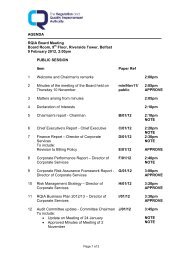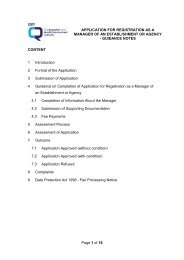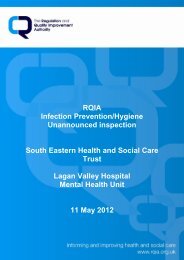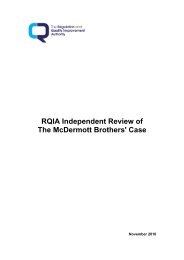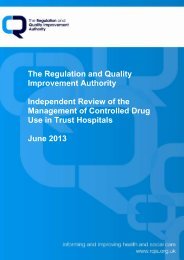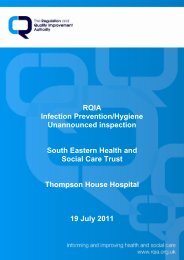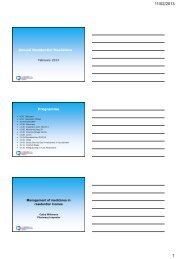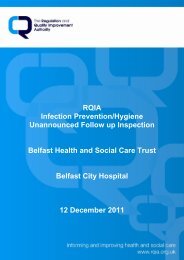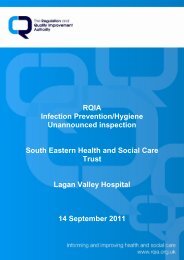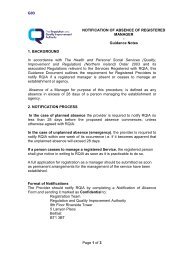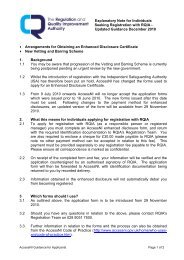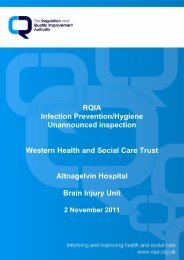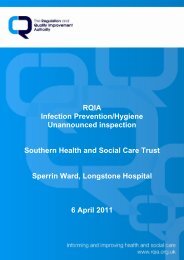Muckamore Abbey Hospital, Antrim - 25 April 2012 - Regulation and ...
Muckamore Abbey Hospital, Antrim - 25 April 2012 - Regulation and ...
Muckamore Abbey Hospital, Antrim - 25 April 2012 - Regulation and ...
You also want an ePaper? Increase the reach of your titles
YUMPU automatically turns print PDFs into web optimized ePapers that Google loves.
RQIA<br />
Infection Prevention/Hygiene<br />
Unannounced Follow up Inspection<br />
Belfast Health <strong>and</strong><br />
Social Care Trust<br />
<strong>Muckamore</strong> <strong>Abbey</strong> <strong>Hospital</strong><br />
<strong>25</strong> <strong>April</strong> <strong>2012</strong>
Contents<br />
1.0 Inspection Summary 1<br />
2.0 Background Information to the Inspection Process 5<br />
3.0 Inspections 6<br />
4.0 Unannounced Inspection Process 7<br />
4.1 Onsite Inspection 7<br />
4.2 Feedback <strong>and</strong> Report of the Findings 7<br />
5.0 Audit Tool 8<br />
6.0 Environment 10<br />
6.1 Cleaning 10<br />
6.2 Clutter 12<br />
6.3 Maintenance <strong>and</strong> Repair 12<br />
6.4 Fixture <strong>and</strong> Fittings 12<br />
6.5 Information 13<br />
7.0 Patient Linen 14<br />
7.1 Management of Linen 14<br />
8.0 Waste <strong>and</strong> Sharps 15<br />
8.1 Waste 15<br />
8.2 Sharps 15<br />
9.0 Patient Equipment 16<br />
10.0 Hygiene Factors 17<br />
11.0 Hygiene Practice 19<br />
12.0 Key Personnel <strong>and</strong> Information 21<br />
13.0 Summary of Recommendations 22<br />
14.0 Unannounced Inspection Flowchart 24<br />
15.0 RQIA Hygiene Team Escalation Policy Flowchart <strong>25</strong><br />
16.0 Action Plan 26
1.0 Inspection Summary<br />
The unannounced inspection undertaken to <strong>Muckamore</strong> <strong>Abbey</strong><br />
<strong>Hospital</strong> on the 16 February <strong>2012</strong> identified issues of minimal<br />
compliance within st<strong>and</strong>ards 2- 7 of the Regional Healthcare Hygiene<br />
<strong>and</strong> Cleanliness St<strong>and</strong>ards. In line with the follow up process an<br />
unannounced inspection was undertaken on the <strong>25</strong> <strong>April</strong> <strong>2012</strong>.<br />
Inspection Outcomes<br />
The inspection team reviewed the progress <strong>and</strong> found 78 per cent of<br />
the preliminary findings had been addressed. The majority of those still<br />
requiring action were in relation to the cleaning of windows, radiators<br />
<strong>and</strong> sanitary areas, replacement of fittings, maintenance <strong>and</strong> repairs.<br />
On the inspection of 16 February <strong>2012</strong>, 26 recommendations were<br />
made in relation to St<strong>and</strong>ards 2-7, 15 have been addressed, 11 have<br />
been repeated <strong>and</strong> there are 3 new recommendations. The following<br />
area was inspected:<br />
Erne Ward<br />
Improvements <strong>and</strong> Developments since the Previous Inspection<br />
The infection prevention <strong>and</strong> control link nurse on the ward has held<br />
various training sessions with staff following the inspection in February,<br />
this included training on a new nursing cleaning schedule, education on<br />
h<strong>and</strong> hygiene both for patients <strong>and</strong> for staff <strong>and</strong> the introduction of<br />
h<strong>and</strong> hygiene audits.<br />
Staff have been supplied with personal h<strong>and</strong> held alcohol rub<br />
dispensers<br />
New flooring was being laid in corridors during the visit<br />
Key Area for Improvement<br />
The timeframe for repairs <strong>and</strong> replacement of fixtures should be<br />
reviewed to ensure the patient’s living spaces are maintained to an<br />
acceptable st<strong>and</strong>ard.<br />
A summary of the recommendations following the re-audit is listed in<br />
Section 13.<br />
A detailed list of the findings from the re-audit is forwarded to Belfast<br />
Health <strong>and</strong> Social Care Trust within 14 days of the inspection to enable<br />
action on recurring or new areas which have achieved non compliant<br />
scores. The draft report which includes the high level<br />
recommendations in a Quality Improvement Plan is forwarded within 28<br />
days of the inspection for agreement <strong>and</strong> factual accuracy. The draft<br />
1
eport is agreed <strong>and</strong> a completed action plan is returned to RQIA within<br />
14 days from the date of issue. The detailed list of preliminary findings<br />
is available from RQIA on request.<br />
The final report <strong>and</strong> Quality Improvement Plan will be available on the<br />
RQIA website. Reports <strong>and</strong> action plans will be subject to performance<br />
management by the Health <strong>and</strong> Social Care Board <strong>and</strong> the Public<br />
Health Agency.<br />
The RQIA inspection team would like to thank the staff at <strong>Muckamore</strong><br />
<strong>Abbey</strong> <strong>Hospital</strong> for their assistance during the inspection.<br />
The following tables give an overview of compliance scores noted in<br />
areas inspected by RQIA:<br />
Table 1 summarises the overall compliance levels achieved.<br />
Tables 2-7 summarise the individual tables for sections two to seven of<br />
the audit tool as this assists organisation to target areas that require<br />
more specific attention.<br />
Table 1<br />
Erne<br />
16 Feb <strong>2012</strong><br />
Erne<br />
<strong>25</strong> <strong>April</strong> <strong>2012</strong><br />
Environment 71 92<br />
Patient Linen 77 84<br />
Waste 79 91<br />
Sharps 86 90<br />
Equipment 44 90<br />
Hygiene Factors 78 93<br />
Hygiene Practices 58 90<br />
Total 70 90<br />
Compliant:<br />
85% or above<br />
Partial Compliance: 76% to 84%<br />
Minimal Compliance: 75% or below<br />
2
Table 2<br />
Environment<br />
Erne<br />
16 Feb <strong>2012</strong><br />
Erne<br />
28 <strong>April</strong> <strong>2012</strong><br />
Reception 84 97<br />
Corridors, stairs lift 65 95<br />
Public toilets 81 100<br />
Ward/department -<br />
68<br />
general(communal)<br />
88<br />
Patient bed area 91 94<br />
Bathroom/washroom 60 79<br />
Toilet 67 82<br />
Clinical<br />
100<br />
81<br />
room/treatment room<br />
Clean utility room N/A N/A<br />
Dirty utility room<br />
N/A<br />
N/A<br />
(Disposal store)<br />
Domestic store 63 86<br />
Kitchen(Servery) 87 96<br />
Equipment store 67 92<br />
Isolation 76 96<br />
General information 39 92<br />
Total 71 92<br />
Linen<br />
Erne<br />
16 Feb <strong>2012</strong><br />
Erne<br />
28 <strong>April</strong> <strong>2012</strong><br />
Storage of clean linen 61 86<br />
Storage of dirty linen 93 86<br />
Laundry facilities N/A N/A<br />
Total 77 86<br />
Waste <strong>and</strong> sharps<br />
H<strong>and</strong>ling,<br />
segregation, storage,<br />
waste<br />
Availability, use,<br />
storage of sharps<br />
Erne<br />
16 Feb <strong>2012</strong><br />
79<br />
86<br />
Erne<br />
28 <strong>April</strong> <strong>2012</strong><br />
91<br />
90<br />
Patient Equipment Erne<br />
Erne<br />
16 Feb <strong>2012</strong> 28 <strong>April</strong> <strong>2012</strong><br />
Patient equipment 44 90<br />
3
Hygiene Factors<br />
Erne<br />
16 Feb <strong>2012</strong><br />
Erne<br />
28 <strong>April</strong> <strong>2012</strong><br />
Availability <strong>and</strong><br />
95<br />
cleanliness of WHB<br />
79<br />
<strong>and</strong> consumables<br />
Availability of alcohol<br />
100<br />
80<br />
rub<br />
Availability of PPE 67 80<br />
Materials <strong>and</strong><br />
95<br />
equipment for<br />
cleaning<br />
85<br />
Total 78 93<br />
Hygiene practices<br />
Erne<br />
16 Feb <strong>2012</strong><br />
Erne<br />
28 <strong>April</strong> <strong>2012</strong><br />
Effective h<strong>and</strong><br />
93<br />
43<br />
hygiene procedures<br />
Safe h<strong>and</strong>ling <strong>and</strong><br />
100<br />
50<br />
disposal of sharps<br />
Effective use of PPE 73 94<br />
Correct use of<br />
N/A<br />
N/A<br />
isolation<br />
Effective cleaning of<br />
80<br />
56<br />
ward<br />
Staff uniform <strong>and</strong><br />
85<br />
70<br />
work wear<br />
Total 58 90<br />
4
2.0 Background Information to the Inspection Process<br />
RQIA’s infection prevention <strong>and</strong> hygiene team was established to<br />
undertake a rolling programme of unannounced inspections of acute<br />
hospitals. The Department of Health Social Service <strong>and</strong> Public Safety<br />
(DHSSPS) commitment to a programme of hygiene inspections was<br />
reaffirmed through the launch in 2010 of the revised <strong>and</strong> updated<br />
version of 'Changing the Culture' the strategic regional action plan for<br />
the prevention <strong>and</strong> control of healthcare-associated infections (HCAIs)<br />
in Northern Irel<strong>and</strong>.<br />
The aims of the inspection process are:<br />
to provide public assurance <strong>and</strong> to promote public trust <strong>and</strong><br />
confidence<br />
to contribute to the prevention <strong>and</strong> control of HCAI<br />
to contribute to improvement in hygiene, cleanliness <strong>and</strong> infection<br />
prevention <strong>and</strong> control across health <strong>and</strong> social care in Northern<br />
Irel<strong>and</strong><br />
In keeping with the aims of the RQIA, the team will adopt an open <strong>and</strong><br />
transparent method for inspection, using st<strong>and</strong>ardised processes <strong>and</strong><br />
documentation.<br />
5
3.0 Inspections<br />
The DHSSPS has devised draft Regional Healthcare Hygiene <strong>and</strong><br />
Cleanliness st<strong>and</strong>ards. RQIA has revised its inspection processes to<br />
support the publication of the st<strong>and</strong>ards which were compiled by a<br />
regional steering group in consultation with service providers.<br />
RQIA's infection prevention/hygiene team have planned a three year<br />
programme which includes announced <strong>and</strong> unannounced inspections<br />
in acute <strong>and</strong> non-acute hospitals in Northern Irel<strong>and</strong>. This will assess<br />
compliance with the DHSSPS Regional Healthcare Hygiene <strong>and</strong><br />
Cleanliness st<strong>and</strong>ards.<br />
The inspections will be undertaken in accordance with the four core<br />
activities outlined in the RQIA Corporate Strategy, these include:<br />
Improving care: we encourage <strong>and</strong> promote improvements in the<br />
safety <strong>and</strong> quality of services through the regulation <strong>and</strong> review of<br />
health <strong>and</strong> social care<br />
Informing the population: we publicly report on the safety,<br />
quality <strong>and</strong> availability of health <strong>and</strong> social care<br />
Safeguarding rights: we act to protect the rights of all people<br />
using health <strong>and</strong> social care services<br />
Influencing policy: we influence policy <strong>and</strong> st<strong>and</strong>ards in health<br />
<strong>and</strong> social care<br />
6
4.0 Unannounced Inspection Process<br />
Trusts receive no advanced notice of the onsite inspection. An email<br />
<strong>and</strong> telephone call will be made by the Chief Executive of RQIA or<br />
nominated person 30 minutes prior to the team arriving on site. The<br />
inspection flow chart is attached in Section 14.<br />
4.1 Onsite Inspection<br />
The inspection team was made up of two inspectors, from RQIA’s<br />
infection prevention/hygiene team. One inspector led the team <strong>and</strong><br />
was responsible for guiding the team <strong>and</strong> ensuring they were in<br />
agreement about the findings reached. Membership of the inspection<br />
team is outlined in Section 12.<br />
The inspection of ward environments is carried out using the draft<br />
Regional Healthcare Hygiene <strong>and</strong> Cleanliness audit tool. The<br />
inspection process involves observation, discussion with staff, <strong>and</strong><br />
review of some ward documentation.<br />
4.2 Feedback <strong>and</strong> Report of the Findings<br />
The process concludes with a feedback of key findings to trust<br />
representatives including examples of notable practice identified during<br />
the inspection. The details of trust representatives attending the<br />
feedback session is outlined in Section 12.<br />
Organisations are forwarded a detailed action plan of preliminary<br />
findings within 14 days of the inspection; this does not include the<br />
findings of the overall organisational systems <strong>and</strong> governance. The<br />
action plan is returned with the agreed draft report. The draft report<br />
contains the high level recommendations of the inspection <strong>and</strong> is<br />
forwarded to each organisation within 28 days of the inspection for<br />
agreement <strong>and</strong> factual accuracy checking <strong>and</strong> returned within two<br />
weeks. The detailed action plan is available on request from RQIA.<br />
The findings of the inspection will be followed up in line with infection<br />
prevention/hygiene inspection process (methodology, follow up <strong>and</strong><br />
reporting).<br />
The infection prevention/hygiene team escalation process will be<br />
followed if inspectors/reviewers identify any serious concerns during<br />
the inspection (Section 15).<br />
A number of documents have been developed to support <strong>and</strong> explain<br />
the inspection process. This information is currently available on<br />
request <strong>and</strong> will be available in due course on the RQIA website.<br />
7
5.0 Audit Tool<br />
The audit tool used for the inspection is based on the Regional<br />
Healthcare Hygiene <strong>and</strong> Cleanliness st<strong>and</strong>ards. The st<strong>and</strong>ards<br />
incorporate the critical areas which were identified through a review of<br />
existing st<strong>and</strong>ards, guidance <strong>and</strong> audit tools (Appendix 2 of Regional<br />
Healthcare Hygiene <strong>and</strong> Cleanliness st<strong>and</strong>ards). The audit tool follows<br />
the format of the Draft Regional Healthcare Hygiene <strong>and</strong> Cleanliness<br />
St<strong>and</strong>ards <strong>and</strong> comprises of the following sections.<br />
1. Organisational Systems <strong>and</strong> Governance: policies <strong>and</strong><br />
procedures in relation to key hygiene <strong>and</strong> cleanliness issues;<br />
communication of policies <strong>and</strong> procedures; roles <strong>and</strong><br />
responsibilities for hygiene <strong>and</strong> cleanliness issues; internal<br />
monitoring arrangements; arrangements to address issues<br />
identified during internal monitoring; communication of internal<br />
monitoring results to staff<br />
This st<strong>and</strong>ard is not audited when carrying out unannounced<br />
inspections however the findings of the organisational system<br />
<strong>and</strong> governance at annual announced inspection will be,<br />
where applicable, confirmed at ward level.<br />
2. General Environment: cleanliness <strong>and</strong> state of repair of public<br />
areas; cleanliness <strong>and</strong> state of repair of ward/department<br />
infrastructure; cleanliness <strong>and</strong> state of repair of patient bed area;<br />
cleanliness <strong>and</strong> state of repair of toilets, bathrooms <strong>and</strong><br />
washrooms; cleanliness <strong>and</strong> state of repair of ward/department<br />
facilities; availability <strong>and</strong> cleanliness of isolation facilities; provision<br />
of information for staff, patients <strong>and</strong> visitors<br />
3. Patient Linen: storage of clean linen; h<strong>and</strong>ling <strong>and</strong> storage of<br />
used linen; ward/department laundry facilities<br />
4. Waste <strong>and</strong> Sharps: waste h<strong>and</strong>ling; availability <strong>and</strong> storage of<br />
sharps containers<br />
5. Patient Equipment: cleanliness <strong>and</strong> state of repair of general<br />
patient equipment<br />
6. Hygiene Factors: h<strong>and</strong> wash facilities; alcohol h<strong>and</strong> rub;<br />
availability of personal protective equipment (PPE); availability of<br />
cleaning equipment <strong>and</strong> materials.<br />
7. Hygiene Practices: h<strong>and</strong> hygiene procedures; h<strong>and</strong>ling <strong>and</strong><br />
disposal of sharps; use of PPE; use of isolation facilities <strong>and</strong><br />
implementation of infection control procedures; cleaning of<br />
ward/department; staff uniform <strong>and</strong> work wear<br />
8
Level of Compliance<br />
Percentage scores can be allocated a level of compliance using the<br />
compliance categories below. The categories are allocated as follows:<br />
Compliant<br />
85% or above<br />
Partial compliance 76 to 84%<br />
Minimal compliance 75% or below<br />
Each section within the audit tool will receive an individual <strong>and</strong> an<br />
overall score, to identify areas of partial or minimal compliance to<br />
ensure that the appropriate action is taken.<br />
9
6.0 Environment<br />
STANDARD 2.0<br />
GENERAL ENVIRONMENT<br />
Cleanliness <strong>and</strong> state of repair of public areas; cleanliness <strong>and</strong><br />
state of repair of ward/department infrastructure; cleanliness <strong>and</strong><br />
state of repair of patient bed area; cleanliness <strong>and</strong> state of repair<br />
of toilets, bathrooms <strong>and</strong> washrooms; cleanliness <strong>and</strong> state of<br />
repair of ward/department facilities; availability <strong>and</strong> cleanliness<br />
of isolation facilities; provision of information for staff, patients<br />
<strong>and</strong> visitors.<br />
Environment<br />
Erne<br />
16 Feb <strong>2012</strong><br />
Erne<br />
28 <strong>April</strong> <strong>2012</strong><br />
Reception 84 97<br />
Corridors, stairs lift 65 95<br />
Public toilets 81 100<br />
Ward/department -<br />
68<br />
general(communal)<br />
88<br />
Patient bed area 91 94<br />
Bathroom/washroom 60 79<br />
Toilet 67 82<br />
Clinical room/treatment<br />
100<br />
81<br />
room<br />
Clean utility room N/A N/A<br />
Dirty utility room(Disposal<br />
N/A<br />
N/A<br />
store)<br />
Domestic store 63 86<br />
Kitchen(Servery) 87 96<br />
Equipment store 67 92<br />
Isolation 76 96<br />
General information 39 92<br />
Total 71 92<br />
The above tables outline the findings in relation to the general<br />
environment of the ward inspected during both inspections. The<br />
findings indicate improvement in all areas, in particular the treatment<br />
room which is now fully compliant. The findings in respect of the<br />
general environment are detailed in the following sections.<br />
6.1 Cleaning<br />
The inspection evidenced that there was improvement to indicate<br />
greater compliance with regional specifications for cleaning, however<br />
more attention to detail was still required in sanitary areas. Staff are<br />
10
commended for achieving overall compliant scores <strong>and</strong> improving the<br />
level of compliance in the<br />
sections within this st<strong>and</strong>ard.<br />
All cleaning issues in relation<br />
to the treatment room have<br />
been addressed <strong>and</strong> there<br />
were no new issues. This<br />
section achieved full<br />
compliance. (Picture 1)<br />
Picture 1: Clean tidy treatment room<br />
In the sanitary areas the inspectors found that more attention to detail<br />
was still required when cleaning. In the single toilet opposite the<br />
equipment store, the toilet bowl was dirty <strong>and</strong> required descaling,<br />
(Picture 2) the fittings on the toilet seat in the shower room were<br />
stained <strong>and</strong> or rusted. The shower fittings on the bath <strong>and</strong> the<br />
underside of the taps in the shower room required cleaning.<br />
Picture 2: Dirty toilet bowl<br />
Cleaning of the large specialist shower chair (Picture 3) had improved,<br />
however crevices required more thorough cleaning, <strong>and</strong> the plastic<br />
sleeve covering the height adjustment leads held dirty stale water. The<br />
underside of the smaller shower chair was also stained.<br />
11
Picture 3: Large specialist shower chair<br />
The hospital has commenced a programme of cleaning radiators, this<br />
needs to be completed as radiators in the lounge, equipment store <strong>and</strong><br />
shower room were still dusty. The external windows throughout the<br />
ward still required cleaning.<br />
6.2 Clutter<br />
The staff on the ward have carried out a de cluttering programme; unused<br />
stock <strong>and</strong> equipment had been removed, this improved the<br />
overall appearance of the ward <strong>and</strong> facilitates the cleaning process.<br />
6.3 Maintenance <strong>and</strong> Repair<br />
A programme of floor replacement scheduled prior to the first<br />
inspection was under way during the visit. It was also noted that in<br />
some areas repairs to wall <strong>and</strong> wood finishes had been made in<br />
preparation for painting. However, there were still holes in the walls of<br />
both single toilets which have not been repaired. Staff should ensure<br />
that all actions <strong>and</strong> repairs detailed on the first report are completed<br />
<strong>and</strong> to an acceptable st<strong>and</strong>ard.<br />
The single toilet No. 69 had a very heavy urine smell, this should be<br />
investigated <strong>and</strong> if necessary the floor replaced.<br />
6.4 Fixtures <strong>and</strong> Fittings<br />
The h<strong>and</strong> towel dispenser in toilet No.69 <strong>and</strong> the toilet roll dispenser in<br />
the toilet opposite the equipment store have still not been replaced,<br />
(Picture 4) although toilet roll was available on a shelf. Staff stated that<br />
dispensers had been ordered, these should be replaced as a matter of<br />
urgency. It is now 9 weeks since the first inspection <strong>and</strong> the lack of<br />
h<strong>and</strong> towels prohibits effective h<strong>and</strong> hygiene for both patients <strong>and</strong> staff.<br />
12
Picture 4: Damage to paint finish on wall<br />
<strong>and</strong> the toilet roll dispenser was missing<br />
6.5 Information<br />
A new nursing cleaning schedule, detailing duties <strong>and</strong> responsibilities<br />
had been introduced; this was completed daily but signed off weekly.<br />
The ward manager advised the trust generic patient equipment<br />
cleaning schedule had just been received <strong>and</strong> that new cleaning<br />
schedules would be drawn up in line with the guidance.<br />
A library of information leaflets was now available in the office <strong>and</strong> a list<br />
of the leaflets had been attached to the lobby door at the entrance to<br />
advise visitors <strong>and</strong> staff to request a copy.<br />
The clip boards in the kitchen <strong>and</strong> dining room still need to be replaced.<br />
Recommendations<br />
1. The trust should ensure that systems <strong>and</strong> processes in place<br />
for environmental cleaning, provide the necessary assurance<br />
that cleaning is carried out effectively. (Repeated)<br />
2. The trust should ensure suitable supplies are held to ensure<br />
timely replacements of fixtures associated with h<strong>and</strong> hygiene.<br />
3. The health care environment should be repaired <strong>and</strong><br />
maintained, <strong>and</strong> damaged fixtures <strong>and</strong> fitting replaced to<br />
maintain public confidence <strong>and</strong> to help reduce the risk of the<br />
spread of infection. (Repeated)<br />
4. Staff should continue to develop nursing cleaning schedules<br />
in line with the trusts guidelines. (Repeated)<br />
13
7.0 Patient Linen<br />
STANDARD 3.0<br />
PATIENT LINEN<br />
Storage of clean linen; h<strong>and</strong>ling <strong>and</strong> storage of used linen; ward/<br />
department laundry facilities.<br />
Linen<br />
Erne<br />
16 Feb <strong>2012</strong><br />
Erne<br />
28 <strong>April</strong> <strong>2012</strong><br />
Storage of clean linen 61 86<br />
Storage of used linen 93 86<br />
Laundry facilities N/A N/A<br />
Total 77 86<br />
7.1 Management of Linen<br />
There has been an improvement in this st<strong>and</strong>ard, the linen store had<br />
been de-cluttered <strong>and</strong> inappropriate items such as chairs <strong>and</strong> h<strong>and</strong>rails<br />
had been removed. The shelving still has to be sealed <strong>and</strong> the walls<br />
painted.<br />
The frame of the used linen skips were damaged <strong>and</strong> some of the<br />
reusable linen bags were again torn.<br />
Recommendations<br />
5. The trust should ensure the correct h<strong>and</strong>ling <strong>and</strong> storage of<br />
clean <strong>and</strong> used linen in a designated area, including<br />
equipment which is clean <strong>and</strong> fit for purpose.<br />
14
8.0 Waste <strong>and</strong> Sharps<br />
STANDARD 4.0<br />
WASTE AND SHARPS<br />
Waste: Effectiveness of arrangements for h<strong>and</strong>ling, segregation,<br />
storage <strong>and</strong> disposal of waste on ward/department<br />
Sharps: Availability, use <strong>and</strong> storage of sharps containers on<br />
ward/department<br />
8.1 Waste<br />
Waste <strong>and</strong> sharps<br />
H<strong>and</strong>ling, segregation,<br />
storage, waste<br />
Availability, use, storage of<br />
sharps<br />
Erne<br />
16 Feb <strong>2012</strong><br />
79<br />
86<br />
Erne<br />
28 <strong>April</strong> <strong>2012</strong><br />
91<br />
90<br />
Correct sharps boxes are now in use, the boxes were held in a locked<br />
cupboard in the treatment room along with the black lidded burn box for<br />
pharmaceutical waste. However, the pharmaceutical waste bin<br />
contained medication paper packaging, this should be disposed of in<br />
the household waste stream.<br />
There were still no waste bins available in the two single toilets.<br />
8.2 Sharps<br />
The temporary closure mechanism on sharps boxes in bathrooms was<br />
not in place. Staff stated they have ordered compatible integral sharps<br />
trays to replace the old worn enamel dish currently in use.<br />
Recommendations<br />
6. The trust should monitor the implementation of its policies<br />
<strong>and</strong> procedures in respect of the management of waste <strong>and</strong><br />
sharps to ensure that safe <strong>and</strong> appropriate practice is in<br />
place. (Repeated)<br />
7. The trust should ensure waste bins are provided at all h<strong>and</strong><br />
washing sinks.<br />
15
9.0 Patient Equipment<br />
STANDARD 5.0<br />
PATIENT EQUIPMENT<br />
Cleanliness <strong>and</strong> state of repair of general patient equipment.<br />
Patient Equipment<br />
Erne<br />
Erne<br />
16 Feb <strong>2012</strong> 28 <strong>April</strong> <strong>2012</strong><br />
Patient equipment 44 90<br />
There has been a significant improvement in the st<strong>and</strong>ard of cleaning<br />
patient equipment <strong>and</strong> staff are to be commended. Staff have carried<br />
out a review of stock held in the treatment room, out of date <strong>and</strong><br />
opened single use supplies have been removed <strong>and</strong> equipment<br />
cleaned. A commode <strong>and</strong> patient wash bowls which were not used<br />
have been disposed of. Inspectors found that the majority of patient<br />
equipment was clean some attention was required to the hoist <strong>and</strong><br />
wheelchairs in the equipment store as these were dusty.<br />
A signing off sheet to show equipment had been cleaned has been<br />
introduced until trigger tape, which identifies equipment is clean <strong>and</strong><br />
ready for use, has been sourced. Staff have received infection<br />
prevention control training since the inspection in February, however,<br />
when questioned some staff were not able to give the symbol for single<br />
use items.<br />
Recommendations<br />
8. The trust <strong>and</strong> individual staff have a collective<br />
responsibility to ensure that patient equipment is clean.<br />
(Repeated)<br />
16
10.0 Hygiene Factors<br />
STANDARD 6.0<br />
HYGIENE FACTORS<br />
H<strong>and</strong> wash facilities; alcohol h<strong>and</strong> rub; availability of PPE;<br />
availability of cleaning equipment <strong>and</strong> materials.<br />
Hygiene Factors<br />
Erne<br />
16 Feb <strong>2012</strong><br />
Erne<br />
28 <strong>April</strong> <strong>2012</strong><br />
Availability <strong>and</strong> cleanliness<br />
95<br />
79<br />
of WHB <strong>and</strong> consumables<br />
Availability of alcohol rub 80 100<br />
Availability of PPE 67 80<br />
Materials <strong>and</strong> equipment<br />
95<br />
85<br />
for cleaning<br />
Total 78 93<br />
Improvement was noted in all sections of<br />
this st<strong>and</strong>ard. The layout of the clinical<br />
room had been changed <strong>and</strong> there was<br />
easy access to the clinical h<strong>and</strong> washing<br />
sink (Picture 5). In the bathroom the<br />
overflow on the h<strong>and</strong> washing sink was<br />
dirty <strong>and</strong> a sink in one of the toilets was<br />
worn.<br />
Picture 5: Accessible clinical<br />
h<strong>and</strong> washing sink<br />
In the shower room, disposable single use aprons <strong>and</strong> gloves were<br />
stored on wall mounted holders, the glove dispenser was beside the<br />
toilet; this increases the potential risk of aerosol contamination. A new<br />
PPE station had been ordered. Before fitting, staff should consult the<br />
Infection Prevention <strong>and</strong> Control team, to ensure the placement of PPE<br />
stations conform with the trust guidance.<br />
In the domestic store, some of the inverted buckets stored on shelves<br />
had not been dried out effectively resulting in pools of water on the<br />
wooden units.<br />
17
Recommendations<br />
9. The trust should ensure that h<strong>and</strong> washing sinks are clean,<br />
working <strong>and</strong> in a good state of repair. (Repeated).<br />
10. The trust should ensure that consumables required to carry<br />
out h<strong>and</strong> hygiene practice are available at all h<strong>and</strong> washing<br />
sinks. (Repeated)<br />
11. The trust <strong>and</strong> individual staff have a collective<br />
responsibility to ensure that PPE is stored appropriately.<br />
(Repeated)<br />
12. Further attention to detail is required to ensure that<br />
equipment used for the general cleaning purposes of a<br />
ward is stored appropriately. (Repeated)<br />
18
11.0 Hygiene Practices<br />
STANDARD 7.0<br />
HYGIENE PRACTICES<br />
H<strong>and</strong> hygiene procedures; h<strong>and</strong>ling <strong>and</strong> disposal of sharps; use<br />
of PPE; use of isolation facilities <strong>and</strong> implementation of infection<br />
control procedures; cleaning of ward/ department; staff uniform<br />
<strong>and</strong> work wear.<br />
Hygiene practices<br />
Erne<br />
16 Feb <strong>2012</strong><br />
Erne<br />
28 <strong>April</strong> <strong>2012</strong><br />
Effective h<strong>and</strong> hygiene<br />
93<br />
43<br />
procedures<br />
Safe h<strong>and</strong>ling <strong>and</strong> disposal<br />
100<br />
50<br />
of sharps<br />
Effective use of PPE 73 94<br />
Correct use of isolation N/A N/A<br />
Effective cleaning of ward 56 80<br />
Staff uniform <strong>and</strong> work<br />
85<br />
70<br />
wear<br />
Total 58 90<br />
The training sessions for staff on hygiene practices following the<br />
February inspection has contributed positively to the improved scores<br />
in this st<strong>and</strong>ard. Staff now all carry their own personal alcohol rub<br />
dispensers.<br />
Nursing staff confirmed that the infection prevention <strong>and</strong> control link<br />
nurse had carried out awareness sessions on cleaning practices,<br />
dilution rates for disinfectants <strong>and</strong> colour coding of cleaning equipment.<br />
However when questioned some staff were still unsure of the correct<br />
dilution rates <strong>and</strong> colour coding. In response, senior managers<br />
discussed the introduction of a competency assessment to validate<br />
staff training.<br />
There is still a need to remind staff of the trust dress code policy as not<br />
all staff were compliant.<br />
Recommendations<br />
13. The trust <strong>and</strong> individual staff have a collective<br />
responsibility to ensure that staff knowledge is kept up to<br />
date with regard to cleaning <strong>and</strong> decontamination of<br />
equipment <strong>and</strong> the environment. (Repeated)<br />
19
14. The trust should ensure that all members of staff are<br />
familiar with <strong>and</strong> adhere to the regional dress code policy.<br />
(Repeated)<br />
20
12.0 Key Personnel <strong>and</strong> Information<br />
Members of the RQIA inspection team<br />
Mrs L Gawley<br />
Mrs M Keating<br />
- Inspector Infection Prevention/Hygiene Team<br />
- Inspector Infection Prevention/Hygiene Team<br />
Trust representatives attending the feedback session<br />
The key findings of the inspection were outlined to the following trust<br />
representatives:<br />
Ms L Mc Bride<br />
Mr B Mills<br />
Mr C Stewart<br />
Ms H Burke<br />
Mr R Davey<br />
Mr D Hamill<br />
Ms R Wilson<br />
- Co Director Patient <strong>and</strong> Client Support Services<br />
- Operations Manager<br />
- Operations Manager<br />
- Ward Sister<br />
- Support Services Manager<br />
- Estates Services Manager<br />
- Assistant Support Services Manager<br />
Apologies<br />
Ms B Creaney<br />
Ms E Rafferty<br />
- Executive Director of Nursing<br />
- Service Manager <strong>Muckamore</strong> <strong>Abbey</strong><br />
Supporting documentation<br />
A number of documents have been developed to support the inspection<br />
process, these are:<br />
Infection Prevention/Hygiene Inspection Process (methodology,<br />
follow up <strong>and</strong> reporting)<br />
Infection Prevention/Hygiene Team Inspection Protocol (this<br />
document contains details on how inspections are carried out <strong>and</strong><br />
the composition of the teams)<br />
Infection Prevention/Hygiene Team Escalation Policy<br />
RQIA Policy <strong>and</strong> Procedure for Use <strong>and</strong> Storage of Digital Images<br />
This information is currently available on request <strong>and</strong> will be available<br />
in due course on the RQIA website.<br />
21
13.0 Summary of Recommendations<br />
1. The trust should ensure that systems <strong>and</strong> processes in place<br />
for environmental cleaning, providing the necessary assurance<br />
that cleaning is carried out effectively. (Repeated)<br />
2. The trust should ensure suitable supplies are held to ensure<br />
timely replacements of fixtures associated with h<strong>and</strong> hygiene.<br />
3. The health care environment should be repaired <strong>and</strong><br />
maintained, <strong>and</strong> damaged fixtures <strong>and</strong> fitting replaced to<br />
maintain public confidence <strong>and</strong> to help reduce the risk of the<br />
spread of infection. (Repeated)<br />
4. Staff should continue to develop nursing cleaning schedules in<br />
line with the trusts guidelines. (Repeated)<br />
5. The trust should ensure the correct h<strong>and</strong>ling <strong>and</strong> storage of<br />
clean <strong>and</strong> used linen in a designated area, including equipment<br />
which is clean <strong>and</strong> fit for purpose.<br />
6. The trust should monitor the implementation of its policies <strong>and</strong><br />
procedures in respect of the management of waste <strong>and</strong> sharps<br />
to ensure that safe <strong>and</strong> appropriate practice is in place.<br />
(Repeated)<br />
7. The trust should ensure waste bins are provided at all h<strong>and</strong><br />
washing sinks.<br />
8. The trust <strong>and</strong> individual staff have a collective responsibility to<br />
ensure that patient equipment is clean. (Repeated)<br />
9. The trust should ensure that h<strong>and</strong> washing sinks are clean,<br />
working <strong>and</strong> in a good state of repair. (Repeated).<br />
10. The trust should that consumables required to carry out h<strong>and</strong><br />
hygiene practice are available at all h<strong>and</strong> washing sinks.<br />
(Repeated)<br />
11. The trust <strong>and</strong> individual staff have a collective responsibility to<br />
ensure that PPE is stored appropriately. (Repeated)<br />
12. Further attention to detail is required to ensure that equipment<br />
used for the general cleaning purposes of a ward is stored<br />
appropriately. (Repeated)<br />
13. The trust <strong>and</strong> individual staff have a collective responsibility to<br />
ensure that staff knowledge is kept up to date with regard to<br />
cleaning <strong>and</strong> decontamination of equipment <strong>and</strong> the<br />
environment. (Repeated)<br />
22
14. The trust should ensure that all members of staff are familiar<br />
with <strong>and</strong> adhere to the regional dress code policy. (Repeated)<br />
23
Reporting & Re-Audit<br />
Episode of Inspection<br />
Plan Programme<br />
14.0 Unannounced Inspection Flowchart<br />
Environmental Scan:<br />
Stakeholders & External<br />
Information<br />
Plan<br />
Programme<br />
Consider:<br />
Areas of Non-Compliance<br />
Infection Rates<br />
Trust Information<br />
RQIA Hygiene Team<br />
Prioritise Themes & Areas for Core Inspections<br />
Prior to Inspection Year<br />
Balance Programme<br />
January/February<br />
Schedule Inspections<br />
Prior to Inspection<br />
Identify & Prepare Inspection Team<br />
Day of Inspection<br />
Inform Trust<br />
Day of Inspection<br />
Carry out Inspection<br />
A<br />
Is there immediate risk<br />
requiring formal escalation?<br />
NO<br />
YES<br />
Invoke<br />
RQIA<br />
IPHTeam<br />
Escalation<br />
Process<br />
Day of Inspection<br />
Feedback Session with Trust<br />
14 days after<br />
Inspection<br />
28 days after<br />
Inspection<br />
Preliminary Findings<br />
disseminated to Trust<br />
Draft Report<br />
disseminated to Trust<br />
NO<br />
Does assessment of<br />
the findings require<br />
escalation?<br />
YES<br />
Invoke<br />
RQIA<br />
IPHTeam<br />
Escalation<br />
Process<br />
A<br />
14 days later<br />
Signed Action Plan<br />
received from Trust<br />
Within 0-3 months<br />
Is a Follow-Up required?<br />
Based on Risk Assessment/key<br />
indicators or Unsatisfactory Quality<br />
Improvement Plan (QIP)?<br />
YES<br />
Invoke<br />
Follow-Up<br />
Protocol<br />
Process enables<br />
only 1 Follow-Up<br />
NO<br />
Open Report published to Website<br />
YES<br />
Is Follow-Up<br />
satisfactory?<br />
NO<br />
DHSSPS/HSC<br />
Board/PHA<br />
PHA<br />
24
15.0 Escalation Process<br />
RQIA Hygiene Team: Escalation Process<br />
B<br />
RQIA IPH<br />
Team<br />
Escalation<br />
Process<br />
Concern / Allegation / Disclosure<br />
Inform Team Leader / Head of Programme<br />
MINOR/MODERATE<br />
Has the risk been<br />
assessed as Minor,<br />
Moderate or Major?<br />
MAJOR<br />
Inform key contact <strong>and</strong> keep a record<br />
Inform appropriate RQIA Director <strong>and</strong> Chief Executive<br />
Record in final report<br />
Inform Trust / Establishment / Agency<br />
<strong>and</strong> request action plan<br />
Notify Chairperson <strong>and</strong><br />
Board Members<br />
Inform other establishments as appropriate:<br />
E.g.: DHSSPS, RRT, HSC Board, PHA,<br />
HSENI<br />
Seek assurance on implementation of actions<br />
Take necessary action:<br />
E.g.: Follow-Up Inspection<br />
<strong>25</strong>
16.0 Action Plan<br />
Reference<br />
number<br />
Recommendations<br />
1. The trust should ensure that systems <strong>and</strong> processes in<br />
place for environmental cleaning, providing the<br />
necessary assurance that cleaning is carried out<br />
effectively. (Repeated)<br />
Designated<br />
department<br />
Nursing<br />
PCSS<br />
IPC<br />
Action required<br />
‘Roles <strong>and</strong> responsibilities of Staff in<br />
relation to Environmental Cleanliness <strong>and</strong><br />
Cleanliness of Equipment’ policy under<br />
review.<br />
Date for<br />
completion/<br />
timescale<br />
Work / negotiations in relation to the<br />
cleaning manual are still ongoing. In<br />
particular, there is discussion with<br />
nursing/control of infection with reference to<br />
bed cleaning. Once agreement is reached<br />
the manual will be finalised.<br />
Jun <strong>2012</strong><br />
2. The trust should ensure suitable supplies are held to<br />
ensure timely replacements of fixtures associated with<br />
h<strong>and</strong> hygiene.<br />
Nursing<br />
PCSS<br />
All of these aspects will be monitored<br />
through the programme of Environmental<br />
Cleanliness Audits based on the<br />
Cleanliness Matters Strategy <strong>and</strong> results<br />
fed back through Balanced Scorecards.<br />
H<strong>and</strong> towel <strong>and</strong> soap dispensers are stock<br />
items <strong>and</strong> once ordered should be received<br />
within 1 week.<br />
Ongoing<br />
Complete<br />
3. The health care environment should be repaired <strong>and</strong><br />
maintained, <strong>and</strong> damaged fixtures <strong>and</strong> fitting replaced to<br />
maintain public confidence <strong>and</strong> to help reduce the risk of<br />
the spread of infection. (Repeated)<br />
4. Staff should continue to develop nursing cleaning<br />
schedules in line with the trusts guidelines. (Repeated)<br />
Estates<br />
IPC<br />
Other<br />
appropriate<br />
staff<br />
Nursing<br />
IPECC<br />
This is ongoing as part of Estate daily<br />
maintenance <strong>and</strong> refurbishment<br />
programmes.<br />
A sub-group of IPECC (Infection Prevention<br />
& Environment <strong>and</strong> Cleanliness Committee)<br />
has been set up to review <strong>and</strong> st<strong>and</strong>ardise<br />
cleaning schedules, <strong>and</strong> will establish any<br />
outst<strong>and</strong>ing issues of audit st<strong>and</strong>ardisation<br />
process.<br />
Ongoing<br />
Complete<br />
* indicates stated for a second time 26
Reference<br />
number<br />
Recommendations<br />
Designated<br />
department<br />
Action required<br />
Agree a st<strong>and</strong>ardised audit which will be<br />
used in all areas. This will include<br />
st<strong>and</strong>ardised responsibilities. To be kept<br />
under review.<br />
Date for<br />
completion/<br />
timescale<br />
Commenced<br />
Feb <strong>2012</strong><br />
Systematic roll out of the agreed<br />
st<strong>and</strong>ardised audit using the Maximiser<br />
system.<br />
5. The trust should ensure the correct h<strong>and</strong>ling <strong>and</strong> storage<br />
of clean <strong>and</strong> used linen in a designated area, including<br />
equipment which is clean <strong>and</strong> fit for purpose.<br />
Nursing<br />
Guidance regarding storage of linen is in<br />
the Regional Infection Prevention Manual.<br />
Linen storage <strong>and</strong> segregation guidance<br />
has been circulated to all Directorates.<br />
Complete<br />
This states that all linen must be stored off<br />
the floor in a clean dedicated area that<br />
allows for ease of access <strong>and</strong> rotation of<br />
stock <strong>and</strong> that Linen rooms must have<br />
shelving that are easy to clean, <strong>and</strong><br />
cleaning frequencies must be at least<br />
quarterly.<br />
6. The trust should monitor the implementation of its<br />
policies <strong>and</strong> procedures in respect of the management of<br />
waste <strong>and</strong> sharps to ensure that safe <strong>and</strong> appropriate<br />
practice is in place. (Repeated)<br />
PCSS<br />
Nursing<br />
The trust will pilot <strong>and</strong> roll out across all<br />
facilities the use of an electronic tool to<br />
audit waste management compliance<br />
against policy, procedure <strong>and</strong> RQIA<br />
requirements. This process will supplement<br />
the existing audit tools used by PCSS, IPC<br />
<strong>and</strong> also existing external audits conducted<br />
by Daniels (sharps box suppliers).<br />
Pilot completed<br />
Roll-out<br />
programme<br />
across Trust<br />
completed Apr<br />
<strong>2012</strong><br />
Daniels’ audit completed Oct 2011 <strong>and</strong><br />
results disseminated.<br />
Complete<br />
7. The trust should ensure waste bins are provided at all<br />
h<strong>and</strong> washing sinks.<br />
PCSS<br />
Nursing<br />
This is monitored as part of the<br />
Environmental Cleanliness Audit<br />
Ongoing<br />
* indicates stated for a second time 27
Reference<br />
number<br />
Recommendations<br />
Designated<br />
department<br />
Programme.<br />
Action required<br />
Date for<br />
completion/<br />
timescale<br />
Regional contract for bins at adjudication<br />
stage.<br />
Environmental cleanliness audit<br />
programmes, which include daily ward<br />
checks, department <strong>and</strong> managerial audits,<br />
<strong>and</strong> IPC audits monitor compliance.<br />
Where an issue has been highlighted,<br />
action will be taken in conjunction with the<br />
appropriate department to ensure<br />
rectification.<br />
8. The trust <strong>and</strong> individual staff have a collective<br />
responsibility to ensure that patient equipment is clean.<br />
(Repeated)<br />
Nursing<br />
PCSS<br />
Work / negotiations in relation to the<br />
cleaning manual are still ongoing. In<br />
particular, there is discussion with<br />
nursing/control of infection with reference<br />
bed cleaning. Once agreement is reached<br />
the manual will be finalised.<br />
Jun <strong>2012</strong><br />
9. The trust should ensure that h<strong>and</strong> washing sinks are<br />
clean, working <strong>and</strong> in a good state of repair. (Repeated)<br />
PCSS<br />
The manual includes roles <strong>and</strong><br />
responsibilities of trust staff in relation to<br />
patient equipment. A template will be used<br />
to record all cleaning of equipment.<br />
This is monitored as part of the<br />
Environmental Cleanliness Audit<br />
Programme. Staff are reminded of the<br />
importance of replenishing dispensers.<br />
Ongoing<br />
Environmental cleanliness audit<br />
programmes, which include daily ward<br />
checks, department <strong>and</strong> managerial audits,<br />
<strong>and</strong> IPC audits monitor compliance.<br />
* indicates stated for a second time 28
Reference<br />
number<br />
Recommendations<br />
Designated<br />
department<br />
Action required<br />
Where an issue has been highlighted,<br />
action will be taken in conjunction with the<br />
appropriate department to ensure<br />
rectification.<br />
Date for<br />
completion/<br />
timescale<br />
10. The trust should ensure that consumables required to<br />
carry out h<strong>and</strong> hygiene practice are available at all h<strong>and</strong><br />
washing sinks. (Repeated)<br />
PCSS<br />
Regular training is provided to all<br />
appropriate staff.<br />
This is monitored as part of the<br />
Environmental Cleanliness Audit<br />
Programme. Staff are reminded of the<br />
importance of replenishing dispensers.<br />
Ongoing<br />
Environmental cleanliness audit<br />
programmes, which include daily ward<br />
checks, department <strong>and</strong> managerial audits,<br />
<strong>and</strong> IPC audits monitor compliance.<br />
Where an issue has been highlighted,<br />
action will be taken in conjunction with the<br />
appropriate department to ensure<br />
rectification.<br />
11. The trust <strong>and</strong> individual staff have a collective<br />
responsibility to ensure that PPE is stored appropriately.<br />
(Repeated)<br />
Nursing<br />
IPC<br />
Regular training is provided to all<br />
appropriate staff.<br />
This is monitored during IPC visits <strong>and</strong><br />
audits.<br />
Ward staff will monitor on an ongoing basis.<br />
Ongoing<br />
12. Further attention to detail is required to ensure that<br />
equipment used for the general cleaning purposes of a<br />
ward is stored appropriately. (Repeated)<br />
Nursing<br />
PCSS<br />
Environmental cleanliness audit<br />
programmes, which include daily ward<br />
checks, department <strong>and</strong> managerial audits,<br />
<strong>and</strong> IPC audits monitor compliance.<br />
Ongoing<br />
Where an issue has been highlighted,<br />
action will be taken in conjunction with the<br />
* indicates stated for a second time 29
Reference<br />
number<br />
Recommendations<br />
Designated<br />
department<br />
Action required<br />
appropriate department to ensure<br />
rectification.<br />
Date for<br />
completion/<br />
timescale<br />
Regular training is provided to all<br />
appropriate staff.<br />
13. The trust <strong>and</strong> individual staff have a collective<br />
responsibility to ensure that staff knowledge is kept up to<br />
date with regard to cleaning <strong>and</strong> decontamination of<br />
equipment <strong>and</strong> the environment. (Repeated)<br />
Nursing<br />
Work / negotiations in relation to the<br />
cleaning manual are still ongoing. In<br />
particular, there is discussion with<br />
nursing/control of infection with reference<br />
bed cleaning. Once agreement is reached<br />
the manual will be finalised.<br />
Role <strong>and</strong> responsibilities policy in place.<br />
Cleaning statements document for all wards<br />
<strong>and</strong> departments to be finalised <strong>and</strong><br />
disseminated. This forms part of the<br />
cleaning manual.<br />
Jun <strong>2012</strong><br />
Complete<br />
Jun <strong>2012</strong><br />
14. The trust should ensure that all members of staff are<br />
familiar with <strong>and</strong> adhere to the regional dress code<br />
policy. (Repeated)<br />
All<br />
Directorates<br />
Trust policy available to all staff on Intranet.<br />
Policy is enforced at local level by senior<br />
staff, e.g., Ward Sisters <strong>and</strong> Senior<br />
Managers.<br />
Complete<br />
The Ward Sister/Charge Nurse Support<br />
Improvement <strong>and</strong> Accountability<br />
Framework (SIAF) includes an indicator<br />
relating to compliance with the dress code<br />
policy <strong>and</strong> this is audited on a quarterly<br />
basis.<br />
Ongoing<br />
* indicates stated for a second time 30
* indicates stated for a second time 31



